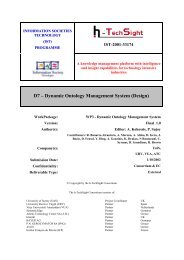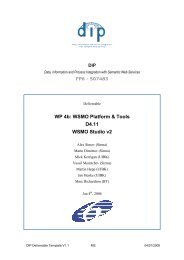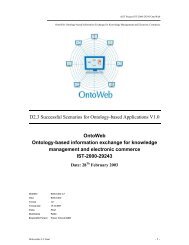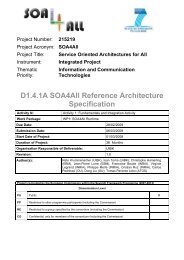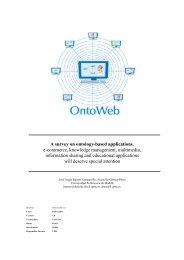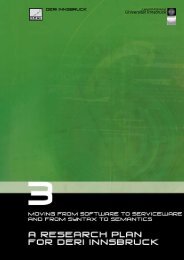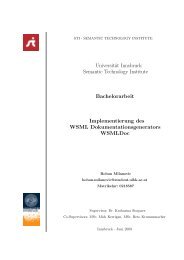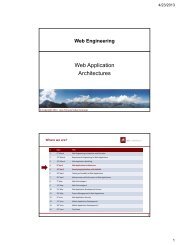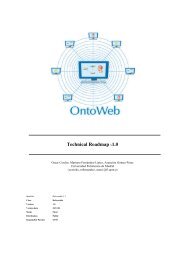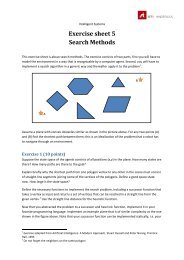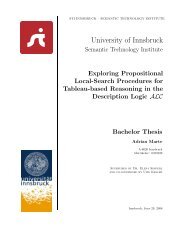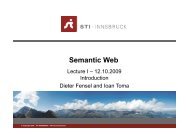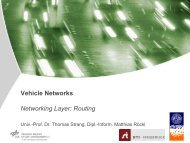Inductive Logic Programming - STI Innsbruck
Inductive Logic Programming - STI Innsbruck
Inductive Logic Programming - STI Innsbruck
Create successful ePaper yourself
Turn your PDF publications into a flip-book with our unique Google optimized e-Paper software.
Intelligent Systems<br />
<strong>Inductive</strong> <strong>Logic</strong> <strong>Programming</strong><br />
© Copyright 2009 Dieter Fensel and Florian Fischer <br />
1
Where are we?<br />
# Title<br />
1 Introduction<br />
2 Propositional <strong>Logic</strong><br />
3 Predicate <strong>Logic</strong><br />
4 Theorem Proving, Description <strong>Logic</strong>s and <strong>Logic</strong> <strong>Programming</strong><br />
5 Search Methods<br />
6 CommonKADS<br />
7 Problem Solving Methods<br />
8 Planning<br />
9 Agents<br />
10 Rule Learning<br />
11 <strong>Inductive</strong> <strong>Logic</strong> <strong>Programming</strong><br />
12 Formal Concept Analysis<br />
13 Neural Networks<br />
14 Semantic Web and Exam Preparation<br />
2
Agenda<br />
• Motivation<br />
• Technical Solution<br />
– Model Theory of ILP<br />
– A Generic ILP Algorithm<br />
– Proof Theory of ILP<br />
– ILP Systems and Applications<br />
• Illustration by a Larger Example<br />
• Summary and Conclusions<br />
3
MOTIVATION<br />
4<br />
4
Motivation<br />
• There is a vast array of different machine learning<br />
techniques, i.e.:<br />
– Reinforcement learning<br />
– Neural networks<br />
– and… <strong>Inductive</strong> <strong>Logic</strong> <strong>Programming</strong> (ILP)<br />
• ILP combines logic with machine learning<br />
– Combine inductive machine learning with representation of logic<br />
programming<br />
– Idea: Induce general rules starting from specific observations +<br />
background knowledge<br />
• Advantages over other ML approaches<br />
– ILP uses an expressive First-Order framework instead of simple<br />
attribute-value framework of other approaches<br />
– ILP can take background knowledge into account<br />
5
<strong>Inductive</strong> <strong>Logic</strong> <strong>Programming</strong><br />
=<br />
<strong>Inductive</strong> Learning ∩ <strong>Logic</strong> <strong>Programming</strong><br />
6
The inductive learning and logic programming<br />
sides of ILP<br />
• From inductive machine learning, ILP inherits its goal: to<br />
develop tools and techniques to<br />
– Induce hypotheses from observations (examples)<br />
– Synthesise new knowledge from experience<br />
• By using computational logic as the representational<br />
mechanism for hypotheses and observations, ILP can<br />
overcome the two main limitations of classical machine<br />
learning techniques:<br />
– The use of a limited knowledge representation formalism<br />
(essentially a propositional logic)<br />
– Difficulties in using substantial background knowledge in the<br />
learning process<br />
7
The inductive learning and logic programming<br />
sides of ILP (cont’)<br />
• ILP inherits from logic programming its<br />
– Representational formalism<br />
– Semantical orientation<br />
– Various well-established techniques<br />
• Compared to other approaches to inductive learning, ILP is<br />
interested in<br />
– Properties of inference rules<br />
– Convergence of algorithms<br />
– Computational complexity of procedures<br />
• ILP systems benefit from using the results of logic programming<br />
– E.g. by making use of work on termination, types and modes,<br />
knowledge-base updating, algorithmic debugging, abduction, constraint<br />
logic programming, program synthesis and program analysis<br />
8
The inductive learning and logic programming<br />
sides of ILP (cont’)<br />
• <strong>Inductive</strong> logic programming extends the theory and<br />
practice of logic programming by investigating induction<br />
rather than deduction as the basic mode of inference<br />
– <strong>Logic</strong> programming theory describes deductive inference from<br />
logic formulae provided by the user<br />
– ILP theory describes the inductive inference of logic programs<br />
from instances and background knowledge<br />
• ILP contributes to the practice of logic programming by<br />
providing tools that assist logic programmers to develop<br />
and verify programs<br />
9
Introduction – Family example<br />
• Imagine yourself as learning about the relationships between people<br />
in your close family circle<br />
– You have been told that your grandfather is the father of one of your<br />
parents, but do not yet know what a parent is<br />
– You might have the following beliefs (B):<br />
grandfather(X, Y) ← father(X, Z); parent(Z, Y)<br />
father(henry, jane) ←<br />
mother(jane. john) ←<br />
mother(jane, alice) ←<br />
– You are now given the following facts (positive examples) concerning<br />
the relationships between particular grandfathers and their<br />
grandchildren (E + ):<br />
grandfather(henry, john) ←<br />
grandfather(henry, alice) ←<br />
– You might be told in addition that the following relationships do not hold<br />
(negative examples) (E - )<br />
← grandfather(john, henry)<br />
← grandfather(alice, john)<br />
10
Introduction – Family example<br />
• Believing B, and faced with the new facts E + and E - you<br />
might guess the following hypothesis H<br />
parent(X, Y) ← mother(X, Y)<br />
• First, we must check that our problem has a solution:<br />
B /\ E - |≠ □ (prior satisfiability)<br />
• However, H allows us to explain E + relative to B:<br />
B /\ H |= E + (posterior sufficiency)<br />
• B and H are consistent with E - :<br />
B /\ H /\ E - |≠ □ (posterior satisfiability)<br />
• The question: how it is possible to derive (even<br />
tentatively) the hypothesis H?<br />
11
Model Theory of ILP, A Generic ILP Algorithm, Proof Theory of ILP, ILP Systems and<br />
Applications<br />
TECHNICAL SOLUTIONS<br />
12<br />
12
Model Theory – Normal Semantics<br />
• The problem of inductive inference:<br />
– Given is background (prior) knowledge B and evidence E<br />
– The evidence E = E + /\ E - consists of positive evidence E + and<br />
negative evidence E -<br />
– The aim is then to find a hypothesis H such that the following<br />
conditions hold:<br />
Prior Satisfiability: B /\ E - |≠ □<br />
Posterior Satisfiability: B /\ H /\ E - |≠ □<br />
Prior Necessity: B |≠ E +<br />
Posterior Sufficiency: B /\ H |= E +<br />
• The Sufficiency criterion is sometimes named completeness with<br />
regard to positive evidence<br />
• The Posterior Satisfiability criterion is also known as consistency<br />
with the negative evidence<br />
13
Model Theory – Definite Semantics<br />
• In most ILP systems background theory and hypotheses are<br />
restricted to being definite<br />
– This setting is simpler than the general setting because a definite clause<br />
theory T has a unique minimal Herbrand model M + (T), and any logical<br />
formulae is either true or false in the minimal model<br />
• This setting is formalised as follows:<br />
Prior Satisfiability: all e in E - are false in M + (B)<br />
Posterior Satisfiability: all e in E - are false in M + (B /\ H)<br />
Prior Necessity: some e in E + are false in M + (B)<br />
Posterior Sufficiency: all e in E + are true in M + (B /\ H)<br />
• The special case of the definite semantics, where the evidence is<br />
restricted to true and false ground facts (examples), is called the<br />
example setting<br />
– The example setting is equivalent to the normal semantics, where B and<br />
H are definite clauses and E is a set of ground unit clauses<br />
14
Model Theory – Non-monotonic Semantics<br />
• In the non-monotonic setting:<br />
– The background theory is a set of definite clauses<br />
– The evidence is empty (Reason: the positive evidence<br />
is considered part of the background theory and the<br />
negative evidence is derived implicitly, by making a<br />
kind of closed world assumption)<br />
– The hypotheses are sets of general clauses<br />
expressible using the same alphabet as the<br />
background theory<br />
15
Model Theory – Non-monotonic Semantics (2)<br />
• The following conditions should hold for H and<br />
B:<br />
– Validity: all h in H are true in M + (B)<br />
• All clauses belonging to a hypothesis hold in the database B, i.e.<br />
that they are true properties of the data<br />
– Completeness: if general clause g is true in M + (B)<br />
then H |= g<br />
• All information that is valid in the database should be encoded in the<br />
hypothesis<br />
– Minimality: there is no proper subset G of H which is<br />
valid and complete<br />
• Aims at deriving non redundant hypotheses<br />
16
Model Theory – Non-monotonic Semantics (3)<br />
• Example for B:<br />
male(luc) ←<br />
female(lieve) ←<br />
human(lieve) ←<br />
human(luc) ←<br />
• A possible solution is then H (a set of general<br />
clauses):<br />
← female(X), male(X)<br />
human(X) ← male(X)<br />
human(X) ← female(X)<br />
female(X), male(X) ← human(X)<br />
17
Model Theory – Non-monotonic Semantics (4)<br />
• Example for B 1<br />
bird(tweety) ←<br />
bird(oliver) ←<br />
• Example for E 1<br />
+<br />
flies(tweety)<br />
• In the example setting an acceptable hypothesis H 1<br />
would be flies(X) ← bird(X)<br />
• In the non-monotonic setting H 1 is not a solution since<br />
there exists a substitution {X ← oliver} which makes the<br />
clause false (non-valid)<br />
18
Model Theory – Non-monotonic Semantics (5)<br />
• The non-monotonic semantics realises induction by<br />
deduction<br />
• The induction principle of the non-monotonic setting<br />
states that the hypothesis H, which is, in a sense,<br />
deduced from the set of observed examples E and the<br />
background theory B (using a kind of closed world and<br />
closed domain assumption), holds for all possible sets of<br />
examples<br />
– This produces generalisation beyond the observations<br />
– As a consequence, properties derived in the non-monotonic<br />
setting are more conservative than those derived in the normal<br />
setting<br />
19
ILP as a Search Problem<br />
• ILP can be seen as a search problem - this view follows<br />
immediately from the model-theory of ILP<br />
– In ILP there is a space of candidate solutions, i.e. the set of<br />
hypotheses, and an acceptance criterion characterizing solutions<br />
to an ILP problem<br />
• Question: how the space of possible solutions can be<br />
structured in order to allow for pruning of the search?<br />
– The search space is typically structured by means of the dual<br />
notions of generalisation and specialisation<br />
• Generalisation corresponds to induction<br />
• Specialisation to deduction<br />
• Induction is viewed here as the inverse of deduction<br />
20
Specialisation and Generalisation Rules<br />
• A hypothesis G is more general than a hypothesis S if<br />
and only if G |= S<br />
– S is also said to be more specific than G.<br />
• In search algorithms, the notions of generalisation and<br />
specialisation are incorporated using inductive and<br />
deductive inference rules:<br />
– A deductive inference rule r in R maps a conjunction of clauses<br />
G onto a conjunction of clauses S such that G |= S<br />
• r is called a specialisation rule<br />
– An inductive inference rule r in R maps a conjunction of clauses<br />
S onto a conjunction of clauses G such that G |= S<br />
• r is called a generalisation rule<br />
21
Specialisation and Generalisation – Examples<br />
• Example of deductive inference rule is resolution; also<br />
dropping a clause from a hypothesis realises<br />
specialisation<br />
• Example of an inductive inference rule is Absorption:<br />
• In the rule of Absorption the conclusion entails the<br />
condition<br />
– Applying the rule of Absorption in the reverse direction, i.e.<br />
applying resolution, is a deductive inference rule<br />
• Other inductive inference rules generalise by adding a<br />
clause to a hypothesis, or by dropping a negative literal<br />
from a clause<br />
22
Soundness of inductive inference rules<br />
• <strong>Inductive</strong> inference rules, such as Absorption, are not<br />
sound<br />
• This soundness problem can be circumvented by<br />
associating each hypothesised conclusion H with a label<br />
L = p(H | B /\ E) where L is the probability that H holds<br />
given that the background knowledge B and evidence E<br />
hold<br />
• Assuming the subjective assignment of probabilities to<br />
be consistent, labelled rules of inductive inference are as<br />
sound as deductive inference<br />
– The conclusions are simply claimed to hold in a certain<br />
proportion of interpretations<br />
23
Pruning the search space<br />
• Generalisation and specialisation form the basis for<br />
pruning the search space; this is because:<br />
– When B /\ H |≠ e, where B is the background theory, H is the<br />
hypothesis and e is positive evidence, then none of the<br />
specialisations H’ of H will imply the evidence. Each such<br />
hypothesis will be assigned a probability label p(H’ | B /\ E) = 0.<br />
• They can therefore be pruned from the search.<br />
– When B /\ H /\ e |= □, where B is the background theory, H is the<br />
hypothesis and e is negative evidence, then all generalisations<br />
H’ of H will also be inconsistent with B /\ E. These will again have<br />
p(H’ | B /\ E) = 0.<br />
24
A Generic ILP Algorithm<br />
• Given the key ideas of ILP as search, inference rules and labeled<br />
hypotheses, a generic ILP system is defined as:<br />
• The algorithm works as follows:<br />
– It keeps track of a queue of candidate hypotheses QH<br />
– It repeatedly deletes a hypothesis H from the queue and expands that<br />
hypotheses using inference rules; the expanded hypotheses are then<br />
added to the queue of hypotheses QH, which may be pruned to discard<br />
unpromising hypotheses from further consideration<br />
– This process continues until the stop-criterion is satisfied<br />
25
Algorithm – Generic Parameters<br />
• Initialize denotes the hypotheses started from<br />
• R denotes the set of inference rules applied<br />
• Delete influences the search strategy<br />
– Using different instantiations of this procedure, one can realise a<br />
depth-first (Delete = LIFO), breadth-first Delete = FIFO) or bestfirst<br />
algorithm<br />
• Choose determines the inference rules to be applied on<br />
the hypothesis H<br />
26
Algorithm – Generic Parameters (2)<br />
• Prune determines which candidate hypotheses are to be<br />
deleted from the queue<br />
– This is usually realized using the labels (probabilities) of the<br />
hypotheses on QH or relying on the user (employing an “oracle”)<br />
– Combining Delete with Prune it is easy to obtain advanced<br />
search strategies such as hill-climbing, beam-search, best-first,<br />
etc.<br />
• The Stop-criterion states the conditions under which the<br />
algorithm stops<br />
– Some frequently employed criteria require that a solution be<br />
found, or that it is unlikely that an adequate hypothesis can be<br />
obtained from the current queue<br />
27
“specific-to-general” vs “general-to-specific”<br />
• “specific-to-general” systems<br />
– Start from the examples and background knowledge, and<br />
repeatedly generalize their hypothesis by applying inductive<br />
inference rules<br />
– During the search they take care that the hypothesis remains<br />
satisfiable (i.e. does not imply negative examples)<br />
• “general-to-specific” systems<br />
– Start with the most general hypothesis (i.e. the inconsistent<br />
clause) and repeatedly specializes the hypothesis by applying<br />
deductive inference rules in order to remove inconsistencies with<br />
the negative examples<br />
– During the search care is taken that the hypotheses remain<br />
sufficient with regard to the positive evidence<br />
28
Proof Theory of ILP<br />
• <strong>Inductive</strong> inference rules can be obtained by inverting deductive<br />
ones<br />
– Deduction: Given B /\ H |= E + , derive E + from B /\ H<br />
– Induction: Given B /\ H |= E + , derive H from B and E - and E +<br />
• Inverting deduction paradigm can be studied under various<br />
assumptions, corresponding to different assumptions about the<br />
deductive rule for |= and the format of background theory B and<br />
evidence E +<br />
⇒ Different models of inductive inference are obtained<br />
– θ-subsumption<br />
• The background knowledge is supposed to be empty, and the deductive inference rule<br />
corresponds to θ-subsumption among single clauses<br />
– <strong>Inductive</strong> inference<br />
• Takes into account background knowledge and aims at inverting the resolution principle, the<br />
best-known deductive inference rule<br />
– Inverting implication<br />
29
Rules of inductive inference and operators<br />
• Inference rules = what can be inferred from what<br />
• A well-known problem: the unrestricted application of inference rules<br />
results in combinatorial explosions<br />
– To control the application of inference rules, the search strategy<br />
employs operators that expand a given node in the search tree into a<br />
set of successor nodes in the search<br />
• A specialisation operator maps a conjunction of clauses G onto a set<br />
of maximal specialisations of S; A maximal specialisation S of G is a<br />
specialisation of G such that<br />
– G is not a specialisation of S<br />
– There is no specialisation S’ of G such that S is a specialisation of S’<br />
• A generalisation operator maps a conjunction of clauses S onto a<br />
set of minimal generalisations of S; A minimal generalisation G of S<br />
is a generalisation of S such that<br />
– S is not a generalisation of G<br />
– There is no generalisation G’ of S such that G is a generalisation of G’<br />
30
θ-subsumption<br />
• A clause c 1 θ-subsumes a clause c 2 if and only if there<br />
exists a substitution θ such that c 1 θ in c 2<br />
– c 1 is a generalisation of c 2 (and c 2 a specialisation of c 1 ) under θ-<br />
subsumption<br />
– Clauses are seen as sets of (positive and negative) literals<br />
• The θ-subsumption inductive inference rule is:<br />
• For example<br />
father(X,Y) ← parent(X,Y), male(X)<br />
θ-subsumes<br />
father(jef,paul) ← parent(jef,paul), parent(jef,ann), male(jef), female<br />
(ann)<br />
with θ = {X = jef, Y = ann}<br />
31
Some properties of θ-subsumption<br />
• Implication: If c 1 θ-subsumes c 2 then c 1 |= c 2<br />
– The opposite does not hold for self-recursive clauses: let c 1 = p(f<br />
(X)) ← p(X); c 2 = p(f(f(Y ))) ← p(Y ); c 1 |= c 2 but c 1 does not θ-<br />
subsume c 2<br />
– Deduction using θ-subsumption is not equivalent to implication<br />
among clauses<br />
• Infinite Descending Chains: There exist infinite<br />
descending chains, e.g.<br />
h(X 1 ,X 2 ) ←<br />
h(X 1 ,X 2 ) ← p(X 1 ,X 2 )<br />
h(X 1 ,X 2 ) ← p(X 1 ,X 2 ),p(X 2 ,X 3 )<br />
h(X 1 ,X 2 ) ← p(X 1 ,X 2 ),p(X 2 ,X 3 ),p(X 3 ,X 4 )<br />
...<br />
This series is bounded from below by h(X,X) ← p(X,X)<br />
32
Some properties of θ-subsumption (2)<br />
• Equivalence: there exist different clauses that are<br />
equivalent under θ-subsumption<br />
– E.g. parent(X,Y) ← mother(X,Y), mother(X,Z) θ-subsumes<br />
parent(X,Y) ← mother(X,Y) and vice versa<br />
• Reduction: for equivalent classes of clauses, there is a<br />
unique representative (up to variable renamings) of<br />
each clause (reduced clause)<br />
– The reduced clause r of a clause c is a minimal subset of literals<br />
of c such that r is equivalent to c<br />
• Lattice: the set of reduced clauses form a lattice, i.e. any<br />
two clauses have unique lub (the least general<br />
generalisation - lgg) and any two clauses have a unique<br />
glb<br />
33
Inverting resolution<br />
• Four rules of inverse resolution<br />
• Lower-case letters are atoms and upper-case letters are<br />
conjunctions of atoms<br />
34
Absorption and Identification<br />
• Both Absorption and Identification invert a single resolution step<br />
• This is shown diagrammatically as a V with the two premises on the<br />
base and one of the arms<br />
• The new clause in the conclusion is the clause found on the other<br />
arm of the V<br />
• Absorption and Identification were called collectively V-operators<br />
35
Inter- and Intra-construction<br />
• The rules of Inter- and Intra-construction introduce a new predicate symbol<br />
• The new predicate can then be generalised using a V-operator;<br />
diagrammatically the construction operators can be shown as two linked<br />
V's, or a W, each respresenting a resolution<br />
• The premises are placed at the two bases of the W and the three<br />
conclusions at the top of the W<br />
– One of the clauses is shared in both resolutions.<br />
• Intra- and Inter-construction are collectively called W-operators<br />
36
V and W operators<br />
• The V and W operators have most specific forms:<br />
• In this form the V-operators realise both generalisation and specialisation<br />
since the conclusions entail the premises<br />
• Use of most specific operators is usually implemented by having a two<br />
stage operation<br />
– In the first phase, inverse resolution operators are applied to examples<br />
– In the second phase clauses are reduced by generalisation through the θ-<br />
subsumption lattice<br />
37
Inverting resolution - Matching subclauses<br />
• Just as resolution requires unification to match terms,<br />
inverse resolution operators require a matching<br />
operation<br />
• In matching operation all clauses, including the<br />
examples are flattened<br />
– This involves introducing a new (n+1)-ary predicate for every n-<br />
ary function symbol, e.g. the clause member(a,[a,b]) ← becomes<br />
member(U,V ) ← a(U), dot(V,U,X), dot(X,Y,Z),b(Y),nil(Z).<br />
– Each new predicate symbol is then separately defined, e.g. dot<br />
([X|Y ],X,Y) ←<br />
– After flattening the problem of matching clauses when applying<br />
the inverse resolution operators reduces to one-sided matching<br />
of clause bodies<br />
38
Characteristics of ILP systems<br />
• Incremental/non-incremental: describes the way the<br />
evidence E (examples) is obtained<br />
– In non-incremental or empirical ILP, the evidence is given at the<br />
start and not changed afterwards<br />
• Non-incremental systems search typically either specific-to-general or general-tospecific.<br />
– In incremental ILP, the examples are input one by one by the<br />
user, in a piecewise fashion.<br />
• Incremental systems usually employ a mixture of specific-to-general and general-tospecific<br />
strategies as they may need to correct earlier induced hypotheses<br />
• Interactive/ Non-interactive<br />
– In interactive ILP, the learner is allowed to pose questions to an<br />
oracle (i.e. the user) about the intended interpretation<br />
• Usually these questions query the user for the intended interpretation of an example or<br />
a clause.<br />
• The answers to the queries allow to prune large parts of the search space<br />
– Most systems are noninteractive<br />
39
Characteristics of ILP systems (2)<br />
• Single/Multiple Predicate Learning/Theory Revision<br />
– Suppose P(F) represent the predicate symbols found in formula<br />
F<br />
– In single predicate learning from examples, the evidence E is<br />
composed of examples for one predicate only, i.e. P(E) is a<br />
singleton<br />
– In multiple predicate learning, P(E) is not restricted as the aim is<br />
to learn a set of possibly interrelated predicate definitions<br />
– Theory revision is usually a form of incremental multiple<br />
predicate learning, where one starts from an initial approximation<br />
of the theory<br />
• Numerical Data<br />
– With a small number of examples it is hard to get enough<br />
examples in which the prediction is an exact number<br />
– Instead rules should predict an interval<br />
40
Concrete ILP implementations<br />
• Extensive list of ILP systems is included in references<br />
• A well known family of related systems: Progol<br />
– CProgol, PProgol, Aleph<br />
• Progol allows arbitrary Prolog programs as background knowledge<br />
and arbitrary definite clauses as examples<br />
• Most comprehensive implementation: CProgol<br />
– Homepage: http://www.doc.ic.ac.uk/~shm/progol.html<br />
• General instructions (download, installation, etc.)<br />
• Background information<br />
• Example datasets<br />
– Open source and free for research and teaching<br />
41
Concrete ILP implementations<br />
• CProgol uses a covering approach: It selects an example to be<br />
generalised and finds a consistent clause covering the example<br />
– Theoretical foundations:<br />
• Inverse entailment with general-to-specific search through a refinement<br />
graph<br />
• S.H. Muggleton. Inverse entailment and Progol. New Generation Computing,<br />
Special issue on <strong>Inductive</strong> <strong>Logic</strong> <strong>Programming</strong>, 13(3-4):245-286, 1995.<br />
• Basic algorithm for CProgol:<br />
1. Select an example to be generalized.<br />
2. Build most-specific-clause. Construct the most specific clause that entails the example<br />
selected, and is within language restrictions provided. This is usually a definite clause<br />
with many literals, and is called the "bottom clause."<br />
3. Find a clause more general than the bottom clause. This is done by searching for<br />
some subset of the literals in the bottom clause that has the "best" score.<br />
4. Remove redundant examples. The clause with the best score is added to the current<br />
theory, and all examples made redundant are removed. Return to Step 1 unless all<br />
examples are covered.<br />
42
Michalski’s train problem<br />
ILLUSTRATION BY A LARGER<br />
EXAMPLE<br />
43<br />
43
Michalski’s train problem<br />
• Assume ten railway trains: five are travelling east and five are<br />
travelling west; each train comprises a locomotive pulling wagons;<br />
whether a particular train is travelling towards the east or towards<br />
the west is determined by some properties of that train<br />
• The learning task: determine what governs which kinds of trains are<br />
Eastbound and which kinds are Westbound<br />
44
Michalski’s train problem (2)<br />
• Michalski’s train problem can be viewed as a<br />
classification task: the aim is to generate a classifier<br />
(theory) which can classify unseen trains as either<br />
Eastbound or Westbound<br />
• The following knowledge about each car can be<br />
extracted: which train it is part of, its shape, how many<br />
wheels it has, whether it is open (i.e. has no roof) or<br />
closed, whether it is long or short, the shape of the<br />
things the car is loaded with. In addition, for each pair of<br />
connected wagons, knowledge of which one is in front of<br />
the other can be extracted.<br />
45
Michalski’s train problem (3)<br />
• Examples of Eastbound trains<br />
– Positive examples:<br />
eastbound(east1).<br />
eastbound(east2).<br />
eastbound(east3).<br />
eastbound(east4).<br />
eastbound(east5).<br />
– Negative examples:<br />
eastbound(west6).<br />
eastbound(west7).<br />
eastbound(west8).<br />
eastbound(west9).<br />
eastbound(west10).<br />
46
Michalski’s train problem (4)<br />
• Background knowledge for train east1. Cars are uniquely identified by<br />
constants of the form car_xy, where x is number of the train to which the car<br />
belongs and y is the position of the car in that train. For example car_12<br />
refers to the second car behind the locomotive in the first train<br />
– short(car_12). short(car_14).<br />
– long(car_11). long(car_13).<br />
– closed(car_12).<br />
– open(car_11). open(car_13). open(car_14).<br />
– infront(east1,car_11). infront(car_11,car_12).<br />
– infront(car_12,car_13). infront(car_13,car_14).<br />
– shape(car_11,rectangle). shape(car_12,rectangle).<br />
– shape(car_13,rectangle). shape(car_14,rectangle).<br />
– load(car_11,rectangle,3). load(car_12,triangle,1).<br />
– load(car_13,hexagon,1). load(car_14,circle,1).<br />
– wheels(car_11,2). wheels(car_12,2).<br />
– wheels(car_13,3). wheels(car_14,2).<br />
– has_car(east1,car_11). has_car(east1,car_12).<br />
– has_car(east1,car_13). has_car(east1,car_14).<br />
47
Michalski’s train problem (5)<br />
• An ILP systems could generate the following hypothesis:<br />
eastbound(A) ← has_car(A,B), not(open(B)), not(long(B)).<br />
i.e. A train is eastbound if it has a car which is both not open and not long.<br />
• Other generated hypotheses could be:<br />
– If a train has a short closed car, then it is Eastbound and otherwise<br />
Westbound<br />
– If a train has two cars, or has a car with a corrugated roof, then it is<br />
Westbound and otherwise Eastbound<br />
– If a train has more than two different kinds of load, then it is Eastbound<br />
and otherwise Westbound<br />
– For each train add up the total number of sides of loads (taking a circle<br />
to have one side); if the answer is a divisor of 60 then the train is<br />
Westbound andotherwise Eastbound<br />
48
Michalski’s train problem – Demo<br />
• Download Progrol<br />
– http://www.doc.ic.ac.uk/~shm/Software/progol5.0<br />
• Use the Progol input file for Michalski's train problem<br />
– http://www.comp.rgu.ac.uk/staff/chb/teaching/cmm510/<br />
michalski_train_data<br />
• Generate the hypotheses<br />
49
SUMMARY<br />
50<br />
50
Summary<br />
• ILP is a subfield of machine learning which uses logic<br />
programming as a uniform representation for<br />
– Examples<br />
– Background knowledge<br />
– Hypotheses<br />
• Many existing ILP systems<br />
– Given an encoding of the known background knowledge and a<br />
set of examples represented as a logical database of facts, an<br />
ILP system will derive a hypothesised logic program which<br />
entails all the positive and none of the negative examples<br />
• Lots of applications of ILP<br />
– E.g. bioinformatics, natural language processing, engineering<br />
• IPL is an active research filed<br />
51
REFERENCES<br />
52<br />
52
References<br />
• S.H. Muggleton. <strong>Inductive</strong> <strong>Logic</strong> <strong>Programming</strong>. New Generation Computing, 8(4):<br />
295-318, 1991.<br />
• S.H. Muggleton and L. De Raedt. <strong>Inductive</strong> logic programming: Theory and methods.<br />
Journal of <strong>Logic</strong> <strong>Programming</strong>, 19,20:629-679, 1994.<br />
• S.H. Muggleton. Inverse entailment and Progol. New Generation Computing, Special<br />
issue on <strong>Inductive</strong> <strong>Logic</strong> <strong>Programming</strong>, 13(3-4):245-286, 1995.<br />
• S.H. Muggleton. Learning from positive data. In S. Muggleton, editor, Proceedings of<br />
the 6th International Workshop on <strong>Inductive</strong> <strong>Logic</strong> <strong>Programming</strong>, p. 225-244, 1996.<br />
• http://en.wikipedia.org/wiki/<strong>Inductive</strong>_logic_programming<br />
• J. Lloyd. <strong>Logic</strong> for learning: learning comprehensible theories from structured data.<br />
2003.<br />
– http://www.cs.bris.ac.uk/~ILPnet2/Tools/Reports/Abstracts/2003-lloyd.html<br />
• S. Dzeroski and N. Lavrac, editors. Relational Data Mining. September 2001.<br />
– http://www.cs.bris.ac.uk/~ILPnet2/Tools/Reports/Abstracts/2001-dzeroski.html<br />
• L. De Raedt, editor. Advances in <strong>Inductive</strong> <strong>Logic</strong> <strong>Programming</strong>. 1996.<br />
– http://www.cs.bris.ac.uk/~ILPnet2/Tools/Reports/Abstracts/rae96:book.html<br />
• N. Lavrac and S. Dzeroski. <strong>Inductive</strong> <strong>Logic</strong> <strong>Programming</strong>: Techniques and<br />
Applications. 1994.<br />
– http://www.cs.bris.ac.uk/~ILPnet2/Tools/Reports/Abstracts/lavdze94:book.html<br />
53
References – Some ILP Implementations<br />
• PROGOL (http://www.doc.ic.ac.uk/~shm/Software/progol5.0)<br />
• Golem (ILP) (http://www.doc.ic.ac.uk/~shm/Software/golem)<br />
• Aleph (<br />
http://web.comlab.ox.ac.uk/oucl/research/areas/machlearn/Aleph/)<br />
• Foil (ftp://ftp.cs.su.oz.au/pub/foil6.sh)<br />
• Claudien (http://www.cs.kuleuven.ac.be/~ml/CWIS/claudien-E.shtml)<br />
• Lime (http://cs.anu.edu.au/people/Eric.McCreath/lime.html)<br />
• ACE (http://www.cs.kuleuven.ac.be/~dtai/ACE/)<br />
• DMax (http://www.pharmadm.com/dmax.asp)<br />
• Warmr (http://www.cs.kuleuven.ac.be/~ml/Doc/TW_User/)<br />
• RSD (http://labe.felk.cvut.cz/~zelezny/rsd/)<br />
• Mio (http://kd.cs.uni-magdeburg.de/~pena/)<br />
• DL-Learner (http://dl-learner.org)<br />
54
Next Lecture<br />
# Title<br />
1 Introduction<br />
2 Propositional <strong>Logic</strong><br />
3 Predicate <strong>Logic</strong><br />
4 Theorem Proving, Description <strong>Logic</strong>s and <strong>Logic</strong> <strong>Programming</strong><br />
5 Search Methods<br />
6 CommonKADS<br />
7 Problem Solving Methods<br />
8 Planning<br />
9 Agents<br />
10 Rule Learning<br />
11 <strong>Inductive</strong> <strong>Logic</strong> <strong>Programming</strong><br />
12 Formal Concept Analysis<br />
13 Neural Networks<br />
14 Semantic Web and Exam Preparation<br />
55
Questions?<br />
56<br />
56



